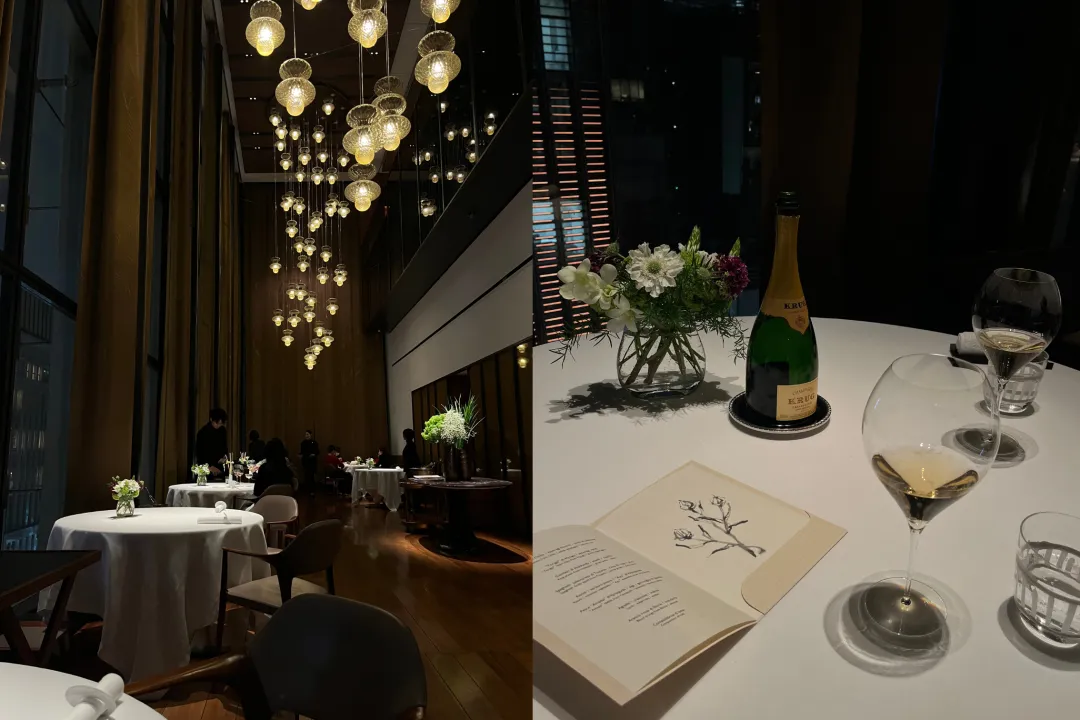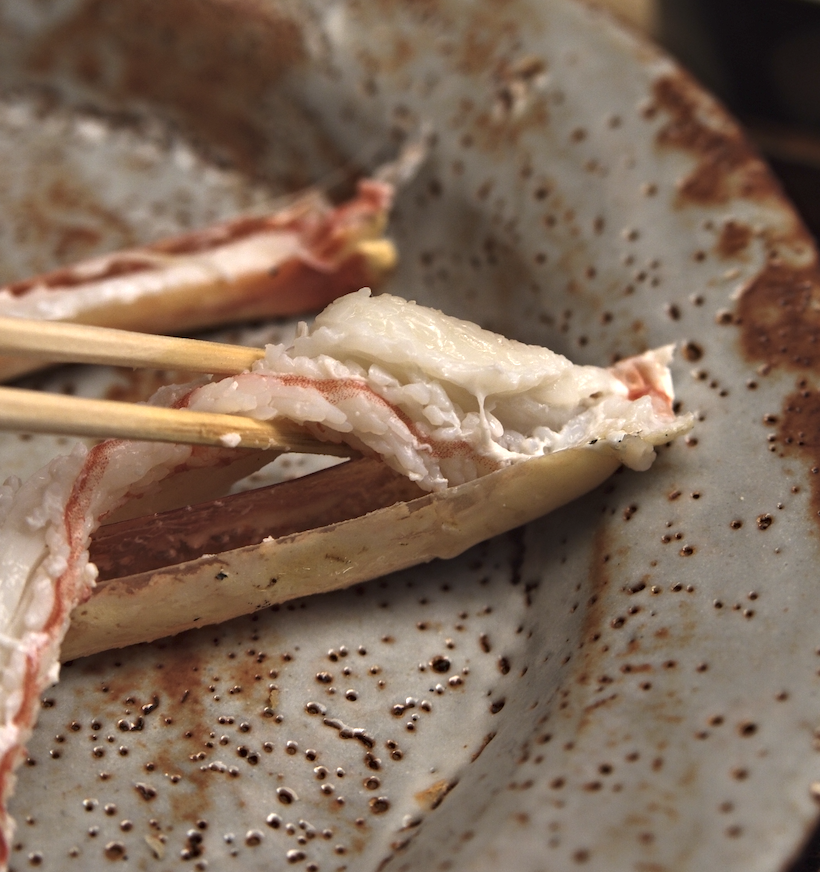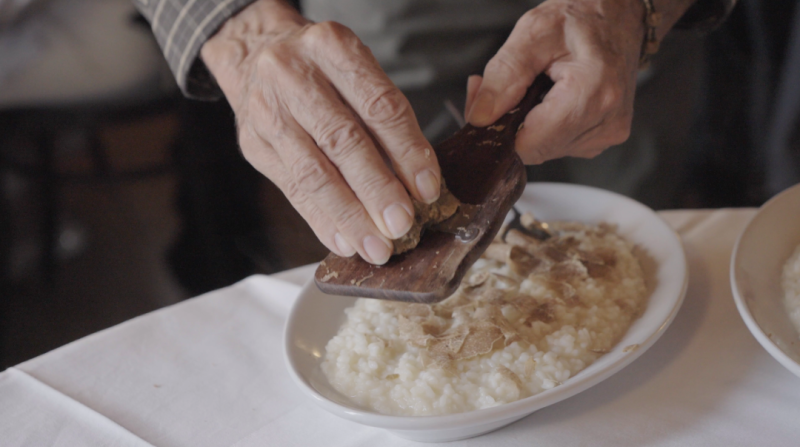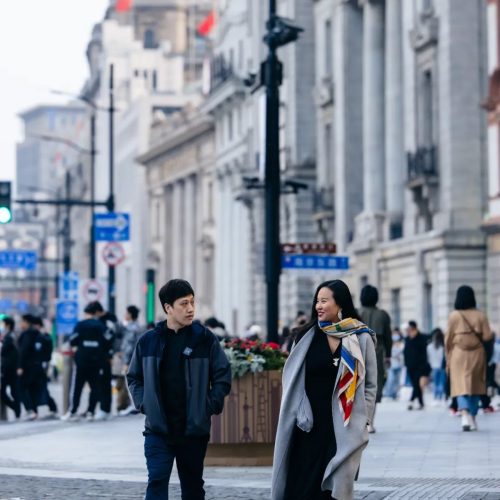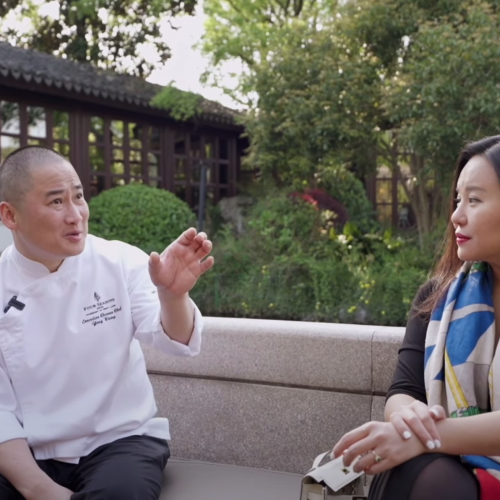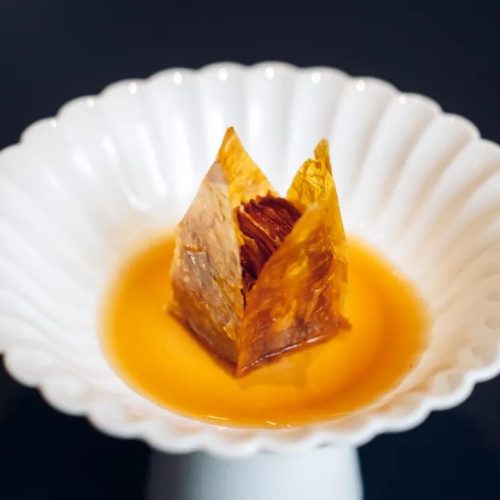“This is the kind of Italian cuisine you can only experience in Japan,” I thought to myself.
This was at Il Ristorante – Luca Fantin, the Italian restaurant in the Bvlgari Ginza Tower, Tokyo. On this chilly, rainy evening in early April, stepping in from the bustling streets of Ginza felt like entering another world. Warm, soft light glowed from the chandeliers suspended from the high ceiling, reminiscent of twinkling stars. Snow-white tablecloths were neatly laid, and through the floor-to-ceiling windows, you could gaze out over Ginza’s skyline. Rain streamed down the glass, blurring the city lights and pedestrians beyond, lending a poetic beauty to the scene.
The meal began with champagne and a trio of amuse-bouches. The most memorable one was a playful take on the classic Italian Caprese salad: a crisp base made from bread flour, topped with mini pickled tomatoes, parsley, cheese cream, and apple sauce. While it lacked the chewy mozzarella, the flavor more than made up for it—the apple sauce was a brilliant touch, adding fruity sweetness to the tomato’s tang. I was already thinking about recreating this as a snack for wine parties at home. The other two amuse-bouches included a Japanese-style takoyaki made with squid ink—fluffy and airy, almost like a fried doughnut—and an edamame cannoli filled with parmesan cream: salty, crispy, and richly savory.
April marks the season for asparagus, which featured prominently in the first two courses. One dish paired raw bonito from Chiba Prefecture, sliced and twirled into a bird’s nest shape like pasta, with a base of silky white asparagus purée. Little slices of white asparagus and salmon roe on top added textural contrast. The bonito was on a leaner side, and I was obsessed with its clean and distinctive acidity. Another dish showcased green asparagus—its green tips were intensely sweet, which were paired with crunchy stems and chewy Japanese cockle (Torigai) from Hyogo Prefecture. The sweetness of sea and vegetable harmonized beautifully.
Next came a dish inspired by the Venetian classic Gamberi in Saor, though this version swapped the traditional cooked shrimp for raw spot-prawn (botan-ebi) from Hokkaido. Translucent and plump, their texture was tender yet firm, with naturally sweet, oceanic richness enhanced by the inclusion of shrimp roe and heads. Peas added a vibrant spring green, each one glossy and full, with a delicate, creamy bite. The sweet and sour onions transported me instantly to a cozy Italian trattoria I used to visit frequently—the familiar flavor struck a nostalgic chord.
Even in these first few courses, Luca Fantin’s style was unmistakable: ingredients take center stage, with plating that evokes poetic grace on pure white ceramics. There’s little story-telling or flashy technique—combinations might be unexpected, but they always work; flavors are direct and striking, like a punch straight to the heart.
While I was still savoring the spot prawn, the next dish arrived under a glass cloche, like a scene from Beauty and the Beast—but instead of a rose, it revealed the first pasta course: firefly squid ink spaghetti. The squid was lightly blanched while rapeseed blossoms offered a bitter-sweet contrast; and the al dente spaghetti was coated in a squid ink sauce rich with the briny umami of firefly squid innards. This was no ordinary squid ink pasta—the firefly squid brought an intense depth of flavor that paired impeccably with the spaghetti. I found myself tearing off chunks of bread to soak up every last drop – Scarpetta scarpetta! The ink smeared at the corner of my mouth? Don’t care.
The next pasta course looked like risotto but was actually risoni, or rice-shaped pasta. Instead of the usual starchy creaminess, it offered a pleasantly firm bite. Served with it was deep-fried sweetish (ayu), a spring and summer delicacy in Japan. While summer is more common for eating sweetfish, in spring they are smaller hence are crispier when fried—biting into one yields its sweet liver and savory bones all at once. The risoni was flavored with spring mountain vegetable sauce, its green aroma balancing the richness of the fried fish. It reminded me of the grilled sweetfish I had late last summer in Toyama at Oryouri Fujii, served with the slightly bitter kick of tadezu (water pepper vinegar). Chef Luca’s take had a similar elegance in its harmony.
The seafood course was amadai (tilefish) from Yamaguchi, slow cooked at low temperature to preserve its tender flesh and rich fat. Its gelatinous skin was meltingly soft, paired with sweet bamboo shoots and an emulsified olive oil sauce—an impeccable marriage of Japanese and Italian techniques. A garnish of sansho leaves added a gentle citrus brightness that cut through the fish’s richness, making me raise my eyebrows in surprise and delight. Then the lamb course arrived—signaling the approaching end of the meal. The lamb, also slow-cooked, was rosy and flavorful, accompanied by black truffle, peppery watercress, bitter chicory, and a rich jus. No frills—just straight-up delicious.
Then came two desserts pairing fruit with panna cotta. One combined thinly sliced kiwi with frozen panna cotta, yogurt gelato, and kiwi sauce infused with non-alcoholic gin—the smooth creaminess beautifully balanced the tartness. Another used blood oranges from Ehime Prefecture—so rich in color that I initially thought they were strawberries. With crunchy biscuit and almonds added, the textures became more layered. A cannoli on the side used dehydrated blood orange slices as the crunchy shell, filled with ricotta ice cream—a playful and inspired touch that made me smile.
Finally was Chef Luca’s signature dessert: 4 Compositions of Milk. A thin sugar shell topped 4 components all made with milk from Hokkaido: fluffy granita, airy cream, velvety semifreddo, and creamy smooth gelato—like four siblings from the same family, each with their own personality, blending into a harmonious quartet. Vanilla seeds added layers of aroma and sweetness, rounding out the milk’s richness. I couldn’t help but marvel—how remarkable it is to turn something as humble as milk into something so nuanced and moving.
Every time I visit Tokyo, besides sushi, Western cuisine has always been one of my top choices. While many Japanese chefs bring their overseas training home and refine their craft here, renowned foreign chefs also settle in Tokyo and blend local ingredients with their own culinary roots—creating Western dishes you can only find in Japan.
Luca Fantin is widely regarded as one of the leading figures in Japanese haute Italian cuisine. His career spans Michelin-starred restaurants in Europe and Japan: Akelarre (3 stars) and Mugaritz (2 stars) in San Sebastián, La Pergola (3 stars) in Rome, and Ryugin (3 stars) in Tokyo. In 2009, he became Executive Chef at the Bvlgari restaurant in Ginza. By 2015, the restaurant was renamed Il Ristorante – Luca Fantin, a clear endorsement of his signature style.
Nowadays when “fusion cuisine” has been a trend, Chef Luca Fantin stays grounded in Italian culinary technique and flavor, using local ingredients to reflect Japan’s seasons. Often inspired by classic Italian dishes, his interpretations surprise with creativity while remaining warm and familiar. Looking back, each dish throughout the menu left a strong impression—memorable, beautifully executed, with techniques and ingredients at his effortless command. Isn’t that the best testament of all?
The only regret? The restaurant is closing on April 26. It will be undergoing a transformation, and Luca Fantin will be stepping away from the restaurant scene—for now. This visit was likely both my first and last. This thought weighed heavy on my heart.
As the meal ended, Chef Luca Fantin came over to chat. Noticing my notebook on the table, he joked that he cooks by intuition, often a little wild and free—so perhaps he should start writing things down to pass on his recipes. I don’t think it necessary though — Even with detailed notes, his dishes could never be truly recreated—they wouldn’t strike the same emotional chord.
I’m so glad that at least I made it to Il Ristorante – Luca Fantin before it’s closed, and I’m already excited for whatever comes next in his journey.
Text & Images: Patty Chuang

